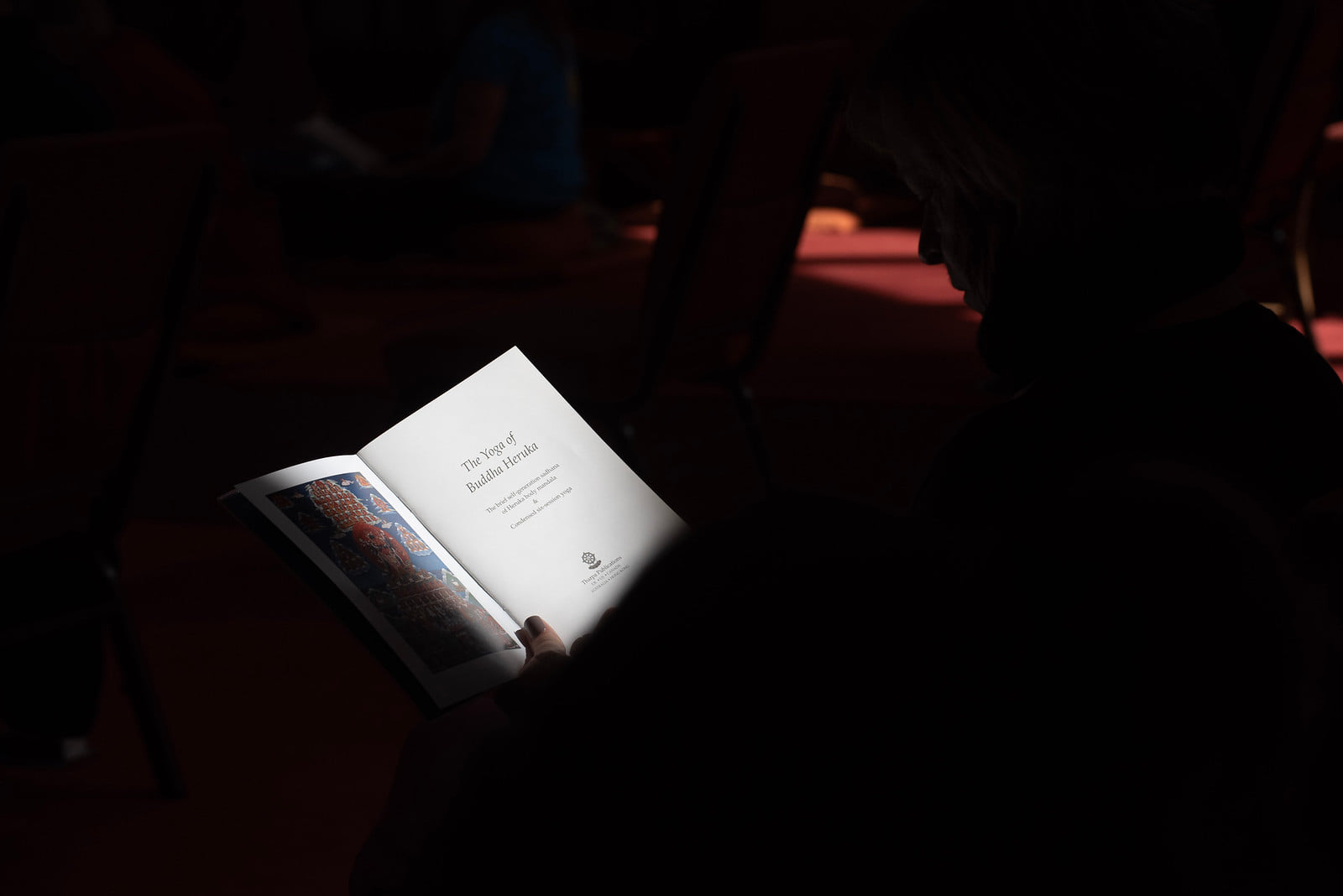Devas and Aliens
Is Buddhist cosmology the key to unlocking UFO mysteries? The post Devas and Aliens appeared first on Tricycle: The Buddhist Review.

Over the years of reading Buddhist scriptures, I’ve always been struck by passages where the Buddha travels to other realms to teach the dharma to divine beings. I’ve been fascinated by images of bodhisattvas riding on clouds and flying in lotus position. The idea of a Pure Land in the far west of the universe sounds pretty much like an alien world. I thought I’d eventually see some X-Files episode or Netflix documentary about alien encounters across Buddhist traditions, but then I thought that even Netflix has its limits, and the idea was too far out.
Now, I’m not so sure. In fact, it might be time to bring this often-overlooked or unknown aspect of Buddhist cosmology to the forefront. Everyone else is talking about aliens. Why should Buddhists be left out of the conversation?
It’s an odd thing that in our technologically and intellectually advanced year of 2024, there’s been a surge of serious discussion about aliens, specifically about unidentified flying objects. The taboo of taking the possibility of UFOs seriously was probably lifted on December 16, 2017, when the New York Times ran a front-page story on the existence of a secret UFO program run by the Pentagon. What truly caught the attention, even of skeptics, was the inclusion of two videos released by the Defense Department. These videos capture encounters between Navy F/A-18 Super Hornets and what are now officially called “unidentified aerial phenomena,” or UAPs. The article, “Glowing Auras and ‘Black Money’: The Pentagon’s Mysterious UFO Program,” caused an overnight cultural shift, because if the Pentagon was admitting they had videos of flying objects that they could not identify, then the rest of us should at least give the matter some consideration.
And that’s precisely what happened. Since 2017, numerous articles, documentaries, and books have discussed the evidence for UAPs. Though most footage is grainy and, to many, is merely blurry lights on a black screen—serious people are now taking this evidence seriously. Politicians, airline pilots, Pentagon scientists, and other government officials openly express bewilderment at the sightings. Without admitting the unidentified flying objects are or belong to aliens, experts also admit they don’t know what they are. In fact, a nine-page report released by the U.S. government on June 25, 2021, revealed there have been 144 military sightings of UAPs since 2004. This highly anticipated but anticlimactic report, which was requested by Congress and written by the Office of the Director of National Intelligence, stated that “Some UAPs appeared to remain stationary in winds aloft, move against the wind, maneuver abruptly, or move at considerable speed, without discernible means of propulsion.” The report’s tone shows the government sees these UAPs as potential threats—both to simple flight safety and to national security.
Just as there are devoted “ufologists” who buy into each new sighting, there are skeptics and debunkers who point out that the so-called UFO is simply an aerodynamic contrail, a bird, a cloud, or a target balloon. But Pentagon officials account for all those possibilities and still maintain that there are things in the sky we cannot identify. Interestingly, most of these things are described as having the same cigar-like shape. A “white Tic Tac” is how many people describe it. And always, the object emanates light.
And it occurred to me: these aren’t “aliens” we’re seeing; they’re spiritual beings. In fact, they’re what Buddhists call devas.
All of this information is thoroughly described in an April 2021 New Yorker article by Gideon Lewis-Kraus, “How the Pentagon Started Taking U.F.O.s Seriously.” While reading the article, something occurred to me: Despite dozens of claims of sightings, the unidentified flying objects never actually interacted with humans. If they were aliens with weaponized technology, they could have, of course, destroyed other flying objects, like airplanes, or even cities and the earth itself. But they haven’t. The objects flew past, often defying the laws of physics, and then vanished. Sightings of them reminded me of sightings of something else: ghosts. And it occurred to me: These aren’t “aliens” we’re seeing; they’re spiritual beings. In fact, they’re what Buddhists call devas. That is to say, according to Buddhist cosmology, aliens are humans who have been reborn in nearby heavenly planes of existence.
Let me explain.
I
’ve been studying Buddhism for over twenty years, and the more familiar I become with Buddhist scripture, the one thing that consistently blows my mind is the vast amount of time it describes. I’m not talking about two or three millennia, but eons. The Buddha, after all, is not a name but a title, and Siddhartha Gotama, the historical Buddha who lived in northern India during the 5th to 4th centuries BCE, is one of several buddhas named in Buddhist scriptures. In fact, there are four buddhas in our current, very auspicious eon, and the remaining buddha of this eon, Mettaya, is due to come once the Buddha’s teachings have disappeared. But other buddhas date to earlier eons. The buddha named Vipassi, for example, is said to have enlightened the world with his teachings ninety-one eons before Gotama Buddha. Ninety-one! And the Buddha himself said he had been preparing to be a buddha for eons. Taking this claim seriously has profound implications—implications that I’ve never heard anyone talk about before.
The Buddhist word for eon is kalpa. In Western discourse, an eon is considered to be about a billion years. But in Buddhism, a kalpa is an incalculable time period; it refers to a complete “world cycle,” the expansion and contraction of the universe. When asked how long a kalpa is, the Buddha replied with a simile: “Suppose there was a solid mass, or rock or hill, one yojana (sixteen miles) in length, width, and height. Once every hundred years, a man will come and stroke it once with a piece of silk cloth. The mass of rock would be worn away and ended sooner than would an eon.” In other words, an eon is an extremely long time—so long that there’s no possible way that Homo sapiens could have existed during the time of buddhas of previous eons because modern humans have been around only for a few hundred thousand years.
And that implication produces a question: If buddhas existed before Homo sapiens, what kind of species were they and their students? Neanderthals? No, because even Neanderthals were around for only a few million years. Perhaps there was a species of humans in the far past whose traces were completely wiped from the earth. That seems rather implausible. It seems more likely that if there were buddhas in past eons, then they must have existed on other planets because the Earth itself is only 4.5 billion years old. Which, in terms of eons, isn’t much.
Thinking about this, it occurred to me: If this is true—and of course, there’s no way we can know whether it’s true or not, but let’s say if this is true—then we humans are the aliens.
We are the space travelers.
I
n a letter to a friend, Herman Hesse wrote that “Buddhism adopts a rational attitude toward the world without gods.” However, anyone familiar with Buddhist scriptures knows that gods are abundant in the Buddha’s discourses. In fact, Buddhist cosmology has thirty-one planes of existence. Along with humans and animals, these planes include a plethora of invisible beings: petas (ghosts), asuras (titans), yakkhas (fairies—both the good and the evil kind), brahmas (higher gods), nagas (serpent-like beings), gandhabbas (celestial musicians), and maras (demons, or hell beings). But most of the planes are home to beings called devas, which means “radiant ones”—the term encompasses anything from angels to minor gods but which we can refer to as spiritual beings.
When I took my first Vipassana course in 2003, I wasn’t familiar with the Buddhist canon, and whenever the teacher, S. N. Goenka, mentioned these spiritual beings, as he frequently does during his taped discourses and chanting, I had no idea what he was talking about. It wasn’t until I read essays by the neglected British Buddhist thinker Francis Story, particularly his “Of Gods and Men” and “Gods and Their Place in Buddhism,” that I not only began to accept the existence of these beings but the theologies of all other religions suddenly made sense. The Greek and Roman gods, deities of the Hindu pantheon, spirits of the Native Americans, djinns, demons, seraphim, cherubim, Yahweh, and Allah—they all fit within Buddhist cosmology as beings in one of the thirty-one planes of existence in which rebirth takes place. As Story reasons, earlier religions “originated from contact with the lower Devas,” while later religions “owe their inspiration to yogic experience of the Brahma worlds.”
Each plane of existence corresponds to a particular mental state, and Buddhists have it all mapped out. They even specify how you can be reborn in one of these deva planes—or a good human birth, for that matter. To have a good human rebirth or be reborn in the lower heavenly planes, for example, requires the cultivation of generosity and virtuous behavior—specifically, observing the five Buddhist precepts to abstain from taking life, taking what is not given, sexual misconduct, speaking falsely, and consuming intoxicants (I know, I know). If you can also cultivate the wholesome mental states of equanimity, compassion, sympathetic joy, and selfless love, you will be reborn in very pleasant heavenly planes. But to be born in the higher heavenly planes—level fifteen and up—you must have specific meditative attainments, according to a graduated system of eight states of meditative absorptions called jhanas. For example, the Buddha describes the third jhana as “With the fading away of rapture, he dwells in equanimity, mindful and discerning; and he experiences in his own person that happiness of which the noble ones say: ‘Happily lives he who is equanimous and mindful’—thus he enters and dwells in the third jhana.” Attain this jhana, and you’ll be reborn on the eighteenth plane, called “Limited Glory Heaven.”
Each plane of existence also corresponds to an average life span, and devas’ life spans are incredibly vast. For example, the life span of a human is more or less one hundred years. The plane just above us is the “Heaven of the Four Great Kings,” in which the life span for beings is about 9,000,000 human years. The length of life span increases at a graduated rate, with the highest spiritual beings living for multiple eons. In the twelfth plane, the “World of the Retinue of Brahma,” beings live for one-third an eon. And in the highest, thirty-first plane, the “Base of Neither-perception-nor-non-perception,” beings live for 84,000 eons. Eighty-four thousand! Try to think about that! But let’s imagine that if a being lived for thousands of eons, it would have existed long before the Big Bang and likely existed during the cycle of many expansions and contractions of many universes.
If so, the question arises: Where do these beings live? Well, obviously, not in a material realm but in a spiritual plane separate from the physical universe. And yet, these spiritual beings are also part of our universe, as the Buddha interacts with them in many scriptures. Devas often come down to earth to listen to the Buddha’s discourses, and the Buddha sometimes goes up to the heavenly planes to give discourses to the gods. In fact, it’s said that the Buddha ascended to the ninth heavenly plane, the “Tusita,” or “Contented,” heaven, specifically to give discourses to his deceased mother who lived there. What’s of note here, in relation to the UFO conversation, is that the Buddha and these spiritual beings travel vast distances through space and many dimensions using the energy of their mind. That is, their movement doesn’t obey the laws of physics. Also of particular note is the tenth plane of existence, the “Heaven of those who Delight in Creation.” Only five planes above us and where the life span is only 2,304 million human years, anything a being in this plane wants to create, they think about it, and voilà, it appears. So if they wanted to create a spiritual spaceship, for example, they’re in the right place to do so.
Another question: What happens to these spiritual beings after their long life span comes to an end? They are reborn, often in much lower realms. As the American-born Buddhist monk Thanissaro Bhikkhu likes to say, when devas fall, they fall hard. We can assume, then, that many beings who were once devas are reborn as human beings.
Accordingly, from a Buddhist perspective, what we call aliens are actually devas. As I wrote earlier, they’re humans who have been reborn in nearby heavenly planes of existence. And it’s because they’re in a different realm that they’re always so elusive—not because they don’t like us.
I
thought I came up with this theory on my own, but when I shared the idea with my wife, she showed me Close Encounters of the Fifth Kind, a documentary film about Dr. Steven Greer, an eccentric emergency room physician turned outspoken ufologist, and who promotes a similar idea. The title refers to deliberately cultivated experiences with UFOs and even “aliens.” What happens is a group of people go out to the desert or a clearing in a forest or somewhere away from the lights of the city, where they burn incense, sit in a circle, and start to meditate. They cultivate wholesome states of mind and then mentally call out to aliens, “vectoring” them to the group’s location. After a while, UFOs appear in the sky above, or bright lights appear on the horizon. The group abruptly turns to look, with many capturing the experience on camera—there is footage of dozens of experiences in the film.
Several times, Greer emphasizes that the “ships” the aliens travel on are “interdimensional.” That is, they appear briefly in our material realm but often quickly appear to dissolve as they go back to their spiritual realm. That’s why, he says, they can travel such vast distances, at speeds much faster than the speed of light, and perform what that Pentagon footage showed as defying the laws of physics—because they’re not operating according to the human realm’s laws of physics. At one point in the film, Greer says that “aliens are people,” and he’s likely more right than he knows. Because he’s implying that aliens are humans who have been reborn in the lower heavenly planes of existence.
Greer refers to these ships coming from “alien civilizations,” which he believes communicate with humans to try to teach us wisdom—for example, that we shouldn’t destroy the Earth with pollution but rather appreciate its beauty. The people in Greer’s circle who have witnessed such UFO interactions claim to be mentally transformed by these experiences. Greer refers to gaining “higher states of consciousness,” but that term is vague. What he means is mental states of goodwill, compassion, equanimity, sympathetic joy, and selfless love. Because these are the mental states that correspond with the heavenly planes of existence from which the UFOs emerge.
I mentioned that I practice Vipassana meditation, as taught by the late S. N. Goenka. The organization is run by assistant teachers, who essentially play recorded tapes of Goenka giving meditation instructions and discourses. During a ten-day meditation course, there are three group sittings a day, and for the last five minutes of each, Goenka chants in the Pali language. And in this chant, he calls to “all the world systems,” to the yakkas, devas, and brahmas—that is, to all beings in the spiritual realms. And, following the Burmese Buddhist tradition in which modern Vipassana originated, Goenka asks these spiritual beings to “rejoice in our merit, which is productive of all prosperity.” He encourages them to “unitedly be devoted to the Buddha’s teaching” and “be without negligence in giving protection.” In the end, he chants that “all the merit we gained, now or previously, we share equally, and may they accept that merit with joy.”
In other words, Buddhists have already been communicating with aliens for a long time. For eons, in fact.
T
o be clear, I don’t necessarily believe Greer’s claims—as I’ve watched more of his films, I’ve concluded that he’s not a reliable person. And I don’t necessarily believe that the Pentagon’s footage is of the unidentified flying phenomenon. I’m not sure if I even believe in Buddhist cosmology—but I want to accept it because it makes more sense than any other explanation. My intention here is not to provide any definitive answers but to add something new and unique to the current conversation about aliens and UFOs and to reframe the discussion within the context of a Buddhist worldview. Through Buddhist cosmology, the mythology of every other religion becomes more plausible and even makes sense. So perhaps Buddhist cosmology can do the same for the mystery of UFOs.
If we really want to find out more about the little green men, we should be talking less to the military and ufologists and more to the saffron-robed men and women of Buddhist traditions. And if you ever want to get off this crazy little planet before it burns up or we destroy it once and for all, well then, you better start meditating.

 Tfoso
Tfoso 





























